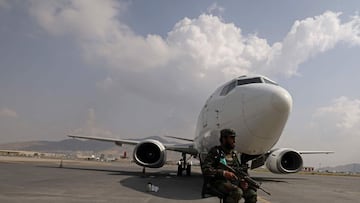How much US equipment did the Taliban get after US withdrawal?
The total amount of US military weapons and equipment seized by the Taliban was unknown, after US forces wrapped up their evacuation on 31 August.


From 2001 through March 2021, the US government allocated the Department of Defense $837.3 billion to finance the invasion of Afghanistan. When accounting for other agencies that received funding as a part of the war effort, like the State Department, this figure is closer to two trillion dollars.
Much of this money was used to train and arm the Afghan Security Forces, including the Afghan National Police, which has ceased to exist since the Taliban took control of the country.
Failures to keep arms out of the hands of the Taliban
When the US military began its withdrawal in May 2021, they used two main methods to “manage military equipment and other material.”
The first, known as 'Retrograde,' represents the “process for the movement of non-unit equipment and materiel from a forward location to a reset (replenishment, repair, or recapitalization) program or to another directed area of operations to replenish unit stocks, or to satisfy stock requirements.”
The second method is known as 'Disposition'. It relates to the “process of reusing, recycling, converting, redistributing, transferring, donating, selling, demilitarizing, treating, destroying, or fulfilling other end of life tasks or actions for DOD property. Does not include real (real estate) property.”
After a twenty-year military conflict, the United States had invested billions in building up the Afghan Security Forces. Before the Taliban took full control of the country in mid-August, the Special Inspector General for Afghanistan Reconstruction had reported that by 5 July, CENTCOM had completed half of its renegade process. This had included the transport of “984 C-17 transport aircraft loads out of Afghanistan." The Special Inspector also reported that "more than 17,000 pieces of equipment [had been] turned over to DLA [the Defense Logistics Agency] for disposition, and 10 facilities, including Bagram Airfield, handed over to Afghanistan’s Ministry of Defense.”
Additionally, the report mentioned that the retrograde process included equipment worth up more than $155 million, including “thousands of vehicles and other equipment.” This includes weapons, tactical vehicles, airplanes, and more.
How much of this equipment is in the hands of the Taliban?
The federal government has reiterated their surprise at the speed at which the Taliban took control of the country. The quick rise to power of the Taliban posed logistical challenges for the withdrawal. With the deadline to have all US forces out of the country by 31 August, the military had to prioritize the evacuation of people rather than the management and transport of weapons and equipment.
This morning, Taliban forces say they finally control all of Afghanistan, claiming to have seized the mountain valley of Panjshir — the last major province not under their control. pic.twitter.com/z5qX5QdLWE
— CBS Mornings (@CBSMornings) September 6, 2021
While withdrawal was ongoing, images of US military equipment captured by the Taliban began circulating on the internet. Many, including the Congressional Research Service, have tried to answer the question of what exactly weapons and materials the Taliban now have in their control. However, without information from the Department of Defense, these calculations are almost impossible to make.
What was given to the Afghan Security Forces?
One way to understand what the Taliban may have been able to seize can be answered by understanding what the US military had purchased to arm the Afghan Security Forces.
In the report released by the Congressional Research Service in late August, researchers wrote that “the Afghan government and other partner nations have received dispositioned U.S. military equipment and materials to advance U.S. national security and foreign policy interests.”
Much of the weapons and equipment left behind during the withdrawal were intended for the Afghan Security Force and given to Afghanistan’s Ministry of Defense, which does not exist anymore.
Additionally, as Afghan Security Forces abandoned the battlefield and their weapons, many were seized by the Taliban. One US official told Reuters that the current intelligence assessment believes that they could now control “2,000 armored vehicles, including U.S. Humvees, and up to 40 aircraft potentially including UH-60 Black Hawks, scout attack helicopters, and ScanEagle military drones.”
As of 12 September, the Department of Defense has yet to make public any information on the number of weapons left in the country and what they estimate could have ended up in the hands of the Taliban.
Let the Blame Game Begin
With the US withdrawal sticking with its 31 August timeline, much blame has been tossed around regarding the chaos and violence seen as military forces, Afghans, and US citizens fled.
Historically, this is not the first time the US government has supplied groups like the Taliban with weapons in Afghanistan. Since the 1980s, the US military and intelligence community have used Afghanistan to target their enemy of the moment. In the early 1980s, Islamist gorilla groups known as the Mujahadeen were armed and trained as a part of CIA Operation Cyclone.
Democrats and Republicans have pointed fingers at President Biden, all three who oversaw the war effort before him. Few, however, have turned their criticism towards the Pentagon, which has led the operation since 2001 and supported previous interventions in the country. The US invasion of Afghanistan was a military intervention. While the President is the head of the military, professionals, and experts are paid to ensure the United States does not invest time and resources that could be used to care for its own people in endless conflicts.
However, the findings of the Afghanistan Papers are evidence that the mission of the US military in this conflict was never truly known and riddled with scandal, waste, and incompetence.
The Afghanistan Papers laid out the failed policy & the level of malfeasance that reach the highest levels of U.S. government. Every level of gov't bears responsibility for creating conditions in which an unchecked military operates without accountability. https://t.co/sd15PfwUcc
— Veterans For Peace (@VFPNational) August 15, 2021
Related stories
With America's longest war over, anti-war activists have been given a larger platform to relay the messages they have been preaching for close to two decades. A mother of an Afghanistan war veteran who lost his life to the conflict released an op-ed detailing how the concerns and opinions of military leaders who did not share an optimistic view of the conflict were ignored for more than a decade.
The author, Mary Hladky, wrote that rather than heading the advice of those tasked with carrying out the mission, "military leadership were more concerned about covering up failures and protecting their jobs than the lives of those on the frontlines." As for the political class, Hladky wrote that leaders from both parties "eagerly accepted large campaign donations from military contractors in exchange for their continued support of the war."

